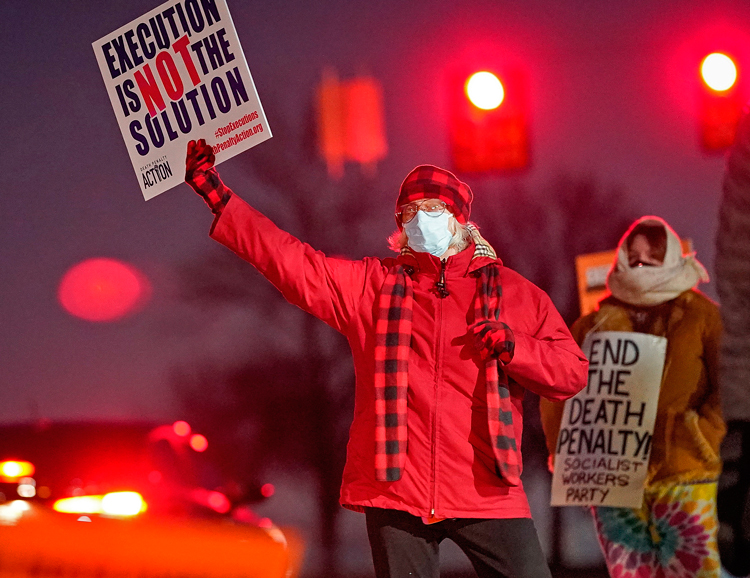Lisa Montgomery, the only woman on federal death row in the U.S., was executed by lethal injection at 1:31 a.m. on Jan. 13. The Supreme Court vacated three different stays by appeals courts, including an order for a competency hearing to determine whether she was mentally fit to be executed.
Only five women had ever been executed by the federal government before Montgomery, including Ethel Rosenberg, framed up during the anti-communist witch hunt and executed in 1953 on charges of conspiring to commit espionage.
Tens of thousands signed clemency petitions to stop the executions of Montgomery and two other federal prisoners. Cory Johnson is set to be executed Jan. 14 and Dustin John Higgs the next day.
Montgomery became the 11th federal inmate executed since July after a 17-year hiatus. This is the most federal executions in a single year since 1896.
All the federal executions take place at the Terre Haute Federal Correctional Complex in Indiana. On “Jan. 12 some 40 people rallied across from the prison to oppose Montgomery’s execution,” Naomi Craine, who joined the protest from Chicago, wrote to the Militant.
“One protester was Charles Keith from Ohio who has been fighting against the death penalty for many years. His brother, Kevin Keith, was on death row for 16 years before his sentence was commuted to life in prison,” said Craine.
Sylvester Edwards, president of the Greater Terre Haute NAACP, told the Militant, “The only way this will end is if we, the people, unite to stop the atrocity of the government carrying out state-sanctioned murder.”
Since Montgomery’s 2007 conviction she had been held in solitary confinement at Carswell medical prison in Fort Worth, Texas, deemed a suicide threat. At least two of her longtime lawyers were infected with coronavirus when they visited her there.
After Montgomery was transported to Terre Haute on Jan. 12 prison authorities held her in a cell in the execution chamber itself, and her reading glasses were taken away.
In 2004, during a psychotic episode, Montgomery traveled from her home in Kansas to Missouri where she killed Bobbie Jo Stinnett, and removed an unborn baby from her womb. Montgomery told people it was hers. This was after she had been forcibly sterilized and faked several other pregnancies.
Montgomery had been diagnosed with multiple mental and neurological disorders as the result of brain damage at birth and being serially beaten and gang-raped by her stepfather and his friends. She was also sexually assaulted and raped by her first husband, and sexually trafficked by her mother.
Montgomery’s co-counsel, Kelley Henry, described her treatment in solitary to the New York Post: “Men see her going to the bathroom. They put her in a suicide gown [a thick garment than can’t be fashioned into a noose] and took away her underwear and socks. She can shower three days per week. I have never had a client, male or female, treated this way.”
Dustin Higgs, 48, was convicted in 1996 of fatally shooting three women on federal wildlife land in Prince George’s County, Maryland, after a dispute at a party. But Willie Haynes, a friend with him that day serving a life sentence, has admitted to killing the women and stated that Higgs did not “order him to do it,” as the prosecution claimed.
During his entire life, Higgs’ 24-year-old son, Da’Quan Darby, has only had contactless visits with his father. Higgs has asthma in addition to COVID-19, so the lethal injection of pentobarbital puts him at greater risk of pulmonary edema, tantamount to death by waterboarding.
The U.S. Justice Department amended its federal execution protocols Nov. 27 to allow executions by firing squad, electrocution and poisonous gas, as well as pentobarbital, if these methods are accepted law in the states where the crimes were committed.
Cory Johnson was sentenced to death along with two other members of a crack-cocaine gang in 1993 in Richmond, Virginia. The three are the longest-serving inmates remaining on federal death row. They were accused of killing 11 people in drug-related activity.
Johnson has been diagnosed as “intellectually disabled” and legally should be exempt from execution. But it wasn’t until after Johnson’s trial that the U.S. Supreme Court voted in 2002 to bar the execution of people with serious mental illness.
In his drive to win the presidential election, Joseph Biden said he now opposes capital punishment, in contrast to his 30-year political record as a senator. T.J. Ducklo, his press secretary, told the media he couldn’t say whether Biden will pause executions.
In 1994 Biden co-authored the Senate version of the “Violent Crime Control and Law Enforcement Act,” which was passed in a bipartisan vote and signed into law by then President Bill Clinton. It added 60 new offenses subject to the federal death penalty. “We do everything but hang people for jaywalking,” Biden bragged at the time.
Seventeen inmates held on state death rows across the country have died from coronavirus, including Ohio death-row prisoner Romell Broom, who died Dec. 28. Broom is remembered for living through one of the most gruesome botched executions in U.S. history in 2009 when executioners attempted to inject a lethal drug cocktail 18 times for over two hours.
Death penalty to intimidate workers
The capitalist rulers keep the death penalty as a way to intimidate working people in hopes of preventing them from standing up and fighting against exploitation and oppression. Opposition to the barbaric practice has been growing for years. In 2019 a Gallup poll on capital punishment reported that for the first time in its 34 years of polling, a majority prefers life imprisonment for murder over the death penalty, by 60% to 36%.


